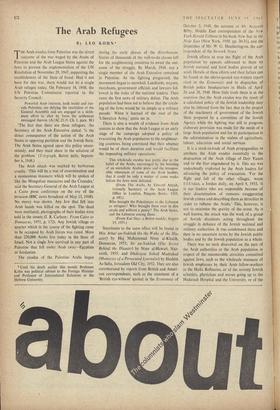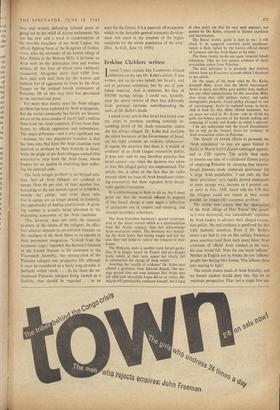The Arab Refugees
It) LEO KOHN*
rr HE Arab exodus from Palestine was the direct I outcome of the war waged by the Arabs of Palestine and the Arab League States against the Jews to prevent the implementation of the UN Resolution of November 29, 1947, supporting the establishment of the State of Israel. Had it not been for this war, there would not be a single Arab refugee today. On February 16, 1948, the UN Palestine Commission reported to the Security Council:
Powerful Arab interests, both inside and out-
side Palestine, are defying the resolution of the General Assembly and are engaged in a delib- erate effort to alter by force the settlement envisaged therein. (A/AC.21 /9. Ch. 1, para. 30.) `The fact that there are these refugees, the Secretary of the Arab Executive stated, 'is the direct consequence of the action of the Arab States in opposing partition and the Jewish State. The Arab States agreed upon this policy unani- mously. and they must share in the solution of the problem.' (Telegraph, Beirut daily, Septem- ber 6, 1948.) The. Arab attack was marked by barbarous cruelty. 'This will be a war, of extermination and a momentous massacre which will be spoken of like, the Mongolian massacres and the Crusades,' said the Secretary-General of the Arab League at a Cairo press conference on the eve of the invasion (BBC news broadcast of May 15, 1948). No mercy was shown. Any. Jew that fell into Arab hands was killed on the spot. The dead were mutilated; photographs of their bodies were sold in the streets (J. R. Carlson: From Cairo to Damascus, 1951, p. 172). Any Jewish village or quarter which in the course of the fighting came to be occupied by Arab forces was razed. More than 220,000 Arabs live today in the State of Israel. Not a single Jew survived in any part of Palestine that fell under Arab sway—Egyptian or Jordanian.
The exodus of the Palestine Arabs began *Until his death earlier this month Professor Kohn was political adviser to the Foreign Minister and Professor of International Relations at the Hebrew University. during the early phases of the disturbances. Scores of thousands of the well-to-do classes left for the neighbouring countries to await the out- come of the struggle. By March, 1948, not a single member of the Arab Executive remained in Palestine. As the fighting progressed, the movement began to snowball. Landlords, mayors, merchants, government officials and lawyers fol- lowed in the wake of the national leaders. Then came the first news of military defeat. The Arab population had been led to believe that the crush- ing of the Jews would be 'as simple as a military parade.' When it learned of the rout of the 'Liberation Army,' panic set in.
There is also a wealth of evidence from Arab sources to show that the Arab League at an early stage of the campaign adopted a policy of evacuating the Arab population to the neighbour- ing countries, being convinced that their absence would be of short duration and would facilitate the impending military operations:
This wholesale exodus was partly due to the belief of the Arabs, encouraged by the boasting of an unrealistic Arabic press and the irrespon- sible utterances of some of the Arab leaders, that it could be only a matter of some weeks before the Jews were defeated.
(From The Arabs, by Edward Atiyah, formerly Secretary of the Arab League Office in London, Penguin Books. 1955, p. 183.)
Who brought the Palestinians to the Lebanon as refugees? Who brought them over in dire straits and without a penny? The Arab States, and the Lebanon among them.
(From Kul Shay, a Beirut weekly, August 19, 1951.) Statements to the same effect will be found in Mitt Athar an-Nakbah (In the Wake of the Dis- aster) by Haj Muhammad Nimr al-Khatib, Damascus, 1951; Sir an-Nakbah (The Secret Behind the Disaster) by Nimr al-Hawari, Naz- areth, 1955; and Dhikrayat Suhufi Mudtahad (Memories of a Persecuted Journalist) by Hashim As-Saba, Jerusalem Old City, 1952. They are also corroborated by reports from British and Ameri- can correspondents, such as the statement of a `British eye-witness' quoted in the Economist of October 2, 1948, the account of N1t Kenneth Bilby, Middle East correspondent of the New York Herald Tribune in his book New Star in the Near East (New York, 1950, pp. 30-31), and the dispatches of Mr. W. G. Heatherington. the cor- respondent of the Newark News.
Jewish efforts to stop the flight of the Arab population by appeals addressed to them by Jewish national and local bodies proved of no avail. Details of these efforts and their failure can be found in the above-quoted eye-witness report cited in the Economist and in dispatches of British police headquarters in Haifa of April 26 and 28, 1948 How little truth there is in the assertion that the Arab exodus was the result of a calculated policy of the Jewish leadership may also be inferred from the fact that in the project of the machinery of government of the Jewish State prepared by a committee of the Jewish Agency while the fighting was still in progress, elaborate provision was made for the needs of a large Arab population and for its participation in the administration in the realms of agriculture, labour, education and social services.
It is a stock-in-trade of Arab propagandists to attribute the Arab exodus essentially to the destruction of the Arab village of Deir Yassin and to the fear engendered by it. This act was undoubtedly exploited by the Arab leaders for advancing the policy of evacuation. 'For the flight and fall of the other villages,' wrote Ul-Urdun, a Jordan daily, on April 9, 1953, 'it is our leaders who are responsible because of their dissemination of rumours exaggerating Jewish crimes and describing them as atrocities in order to inflame the Arabs.' This, however, is not to minimise the gravity of the event. As is well known, the attack was the work of a group of Jewish dissidents acting throughout the struggle in defiance of the Jewish national and military authorities. It was condemned there and then in no uncertain terms by the Jewish public bodies and by the Jewish population as a whole.
There was no such disavowal on the part of the Arab authorities or the Arab population in respect of the innumerable atrocities committed against Jews, such as the wholesale massacre of Jewish employees by their Arab fellow-workers in the Haifa Refineries, or of the seventy Jewish scientists, physicians and nurses going up to the Hadassah Hospital and the University, or of the men and women defending isolated posts or going out to the relief of distant settlements. No one has ever said a word in condemnation of the horrible treachery of the Arab Legion, the official fighting force of the Kingdom of Jordan, when. after the surrender of the Jewish village of Kfar Etzion in the Hebron Hills, it let loose an Arab mob on the defenceless men and women settlers, all but four of whom were ruthlessly massacred. Altogether more than 6,000 Jews have paid with their lives for the wanton and ruthless war of aggression let loose by the Arab League on the isolated Jewish community of Palestine. Of all this very little has percolated to the international press.
For more than twelve years the Arab refugee problem has been exploited by Arab propaganda, but the world community has hardly yet become aware of the mass exodus of nearly half a million Jews from the Arab countries, driven from their homes by official oppression and intimidation. The major difference—and a very significant one --between the two population transfers is that the Jews who fled from the Arab countries were received as brethren by their kinsfolk in Israel, while the plight of the Arab refugees evoked little constructive help from the Arab hosts, whose leaders felt no qualms in exploiting their suffer- ing for political ends.
The Arab refugee problem is not beyond solu- tion. Not all Arab refugees are confined to camps. Over 60 per cent. of their number live, according to the last annual report of UNRWA, outside the camps; and even those who live in camps are no longer denied, as formerly, the opportunity of finding employment. A grow- ing number is actually being absorbed in the expanding economies of the Arab countries.
This, however, does not settle the essential problem of the future of the refugees. Its effec- tive solution depends in pre-eminent measure on the readiness of the Arab States to co-operate in their permanent integration. 'Viewed from the economic angle;* reported the Secretary-General of the United Nations in his statement to the Fourteenth Assembly, `the reintegration of the Palestine refugees into productive life, although it must be considered as a fairly long process, is perfectly within reach. . . . So far from the un- employed Palestine refugees being viewed as a liability, they should be regarded . . . as an asset for the future; it is a reservoir of manpower which in the desirable general economic develop- ment will assist in the creation of the higher standards for the whole population of the area.' (Doc. A/412I, June 15, 1959.)











































 Previous page
Previous page